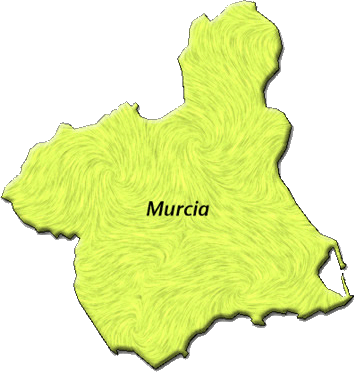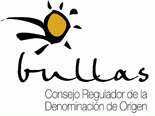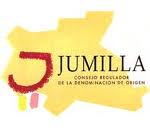Murcia DOs

Murcia is an autonomous community in the southeast of Spain, bordering with Andalusia on the southwest, Castile la Mancha on the northwest, the Valencian Community in the northeast and the Mediterranean sea in the southeast. As far as we know, Murcia was founded in 825 by the emir of Al-Andalus, Abd ar-Rahman II, under the name Medinat Mursiya (city of Murcia). It appears that before the Muslim invasion, there was a Roman settlement under the name of Murtia. Murcia is crossed by the Segura river, and the Muslims taught Spanish farmers how to form a network of canals and ditches that would spread water across the whole of Murcia. It was during this time that the exploitation of Murcia's orchards became one of the major economic motors of the region. Although alcohol was prohibited under the Quran, it's probable that with the new watering system the production of the wines of Murcia increased during this time.
During the second half of the 12th century, Murcia became one of the most important cities of the Muslim world. It was Alfonso X in 1234 who subjected Murcia to servitude through the Treaty of Alcatraz, and as a protectorate made it part of the reign of Castile. In 1264 the Mudejars rebelled against the Christian reign, and Alfonso X sent his cousin Jaime I of Aragon to deal with them. Jaime won, Murcia lost its Muslim autonomy and the city was repopulated with Christians, mainly with Catalan and Aragonese people that had arrived with Jaime. Festivities ensued, and the wines of Murcia ran down the streets as everyone celebrated the victory.
During the 14th century there was a deep crisis in Murcia, which affected the agriculture and thus the whole city. The main cause was the plague or Black Death, but the general insecurity that derived from being so close to the enemy (the Muslims had established themselves in Granada) didn't help the situation. After Granada was reconquered and the enemy was defeated (mid 15th century) the economic recovery began, and with it the orchards and the vineyards responsible for the production of the wines of Murcia were restored. During the 16th century Murcia was given the distinction of Very Noble and Very Loyal for the help given in defeating the Moors. The 16th century saw the return of the Plague in the area, which, coupled with the flash flood in 1651 that killed over 1000 people, sank Murcia into another crisis.
During the 17th century Murcia went through a big economic expansion based on the increased production in the agricultural areas. The orchards expanded beyond their previous limits and gave way to human settlements near them, which later turned into all the villages that now surround Murcia. It quite possible that the situation of the current DOs that produce wines of Murcia was settled during this time. This exodus to the country reflected in the architecture and planning of the town, and for the first time since the founding of the city, people established their homes on the other side of the Segura river (this area is now known as El Barrio del Carmen). This richness couldn't last, and at the beginning of the 19th century Murcia was looted by the Napoleonic troops, followed by a huge earthquake a few years later, where around 6000 people died. The ill disposal of the bodies and the unsanitary conditions brought another plague and cholera epidemic. Murcia suffered again from flash floods in 1879 and 1907, though the construction of a dam helped to keep later floods at bay.
Even though Murcia hasn't been a particularly buoyant city in many years, it has undergone a great economic and demographic growth during the 20th century. Agriculture continues to be it's main economic sector, but tourism is coming close behind. Murcia is known for its beaches and wonderful weather, but it's also a great place to visit if you're interested in or are taking any Spanish history courses because of all the monuments, buildings and remains from the different cultures that inhabited Murcia.
DOs (designations of origin) in Murcia
Murcia is often referred to as "Europe's Orchard" because its main economic activity is the agriculture and exportation of fruits (mainly lemons and oranges) to the rest of Europe. However, it's also well known throughout the world for its excellent wines of Murcia, specially the reds from DO Jumilla. Murcia has three designations of origin, all concentrated in the north of the autonomous community.
DO Bullas

DO Bullas is located in the northwest of Murcia. Due to the differences in soil, climate and precipitation rate, there are three main sub areas:
- West - Northwest: Contains around 50% of all the vineyards in the DO Bullas. Vines are normally planted between 1600 and 2600 feet of altitude on the slopes of the surrounding mountains.
- Central: Houses around 40% of the vineyards, planted between 1600 and 1900 feet of altitude.
- North - Northeast: Around 10% of the vineyards are planted in this area, between 1300 and 1600 feet of altitude.
The general characteristics of the climate in this area are: very hot summers, with sudden bursts of cold wind and possible frosts in winter. Precipitations come in the form of storms and sudden downpours that never last long. The grapes accepted by this DO are Cabernet Sauvignon, Merlot, Syrah, Tempranillo, Garnacha, Monastrell, Macabeo and Airén. The alcohol content in these wines of Murcia is:
- Red: alcohol content between 12% and 14%
- White: alcohol content between 10% and 12.5%
- Rosé: alcohol content between 11% and 12.5%
DO Jumilla

DO Jumilla produces the best known wines of Murcia. The influence of the Mediterranean softens the climate by which these grapes are affected and produces soft, balanced wines of high quality. Don't you want to learn more about their history?
DO Yecla

DO Yecla is located in the northeast of Murcia. Their vineyards are planted between the 1300 and 2600 feet of altitude. The climate in the area is continental with Mediterranean influences, which means long hot summers and shorter cold winters, and not much rain overall.
An 80% of the production of DO Yecla is dedicated to red wines of Murcia, mainly using the Monastrell variety, although there are other grapes allowed: Garnacha, Tempranillo, Merlot, Cabernet Sauvignon and Syrah. Their production of white wine is very low, and the accepted varieties are Airen, Macabeo, Merseguera and Malvasía. The alcohol percentage in these wines is:
- White: Minimum alcohol content of 10.5%
- Rosé: Must be produced with at least a 60% of Monastrell. Minimum alcohol content of 11%.
- Red: Must be produced with at least a 60% of Monastrell. Minimum alcohol content of 12.5%.
- Liquor wines: 100% Monastrell. Minimum alcohol content of 15%.
- Sparkling wines: Produced using traditional methods. In rosés and reds it must contain at least an 85% of the Monastrell variety. Minimum alcohol content of 11.5%.
Murcia is a very traditional region, so if you're looking for a full immersion in Spanish culture you should definitely visit the "Huerta de Murcia" or try to catch some of the traditional festivities like "El Bando de la Huerta".
Spanish Wine History
Spanish Wine Regions and DO
Spanish Wine Tours
Top Spanish designations of origin
Best Spanish Wines
Spanish Wine Production
Spanish Wine Types
Spanish Grapes
Spanish Sparkling Wine: Cava
Sherry Wine
Spanish Wine Cocktails
Spanish Wines in the World
Spanish Wine Prizes
Enotourism
Spanish spirits and liquors
Argentina Wines
Chilean Wines
Other sites